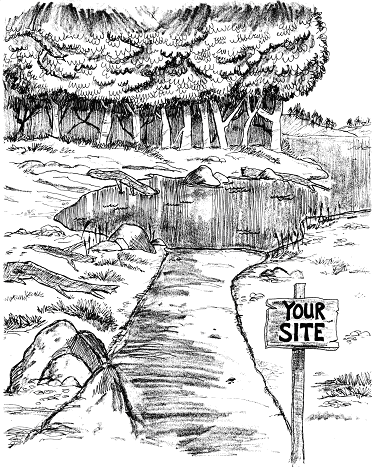
What gets me is you work all your life like a dog,
you pay into these government programs.
But still, when you need help, the people that are paid to help you
they act like it's coming out of their own pocket.
- Artie Chandler
In theory, a public agency overseeing building and land development is on your side! Public agencies exist in order to protect the interests of the citizenry, and there is certainly no reason to encourage an adversarial-type relationship. The purpose of building departments and codes is to provide standards to safeguard the health, safety, and property of the community.
Remember: Cooperation with plan examiners and field inspectors is going to be more effective than confrontation and conflict.
Historically, there have been three "standard" building codes in the United States: building codes have been developed by the International Conference of Building Officials, Building Officials and Code Administrators, and Southern Building Code Congress. ICBO's Uniform Building Code has been the most widely adopted, but recently many states are adopting the International Residential Building Code and the IRC is NOW generally recognized as America's standard code. You should check with your Building Department to identify which code is applied in your area and where you can obtain copies of applicable codes and ordinances.
As you consider where to build your home, you'll want to be sure the site conforms to local codes and ordinances BEFORE you purchase the lot.

When you obtain a residential Building Permit, your project may be checked to meet the requirements of the following codes and ordinances:
- International Residential Code
- Uniform Mechanical Code
- Uniform Plumbing Code
- National Electric Code
- Uniform Fire Code
- Sensitive Areas Provisions and Administrative Rules
- Storm water / Drainage Ordinance
- County Zoning Code
- Energy Code
- Ordinances and policies adopted by your County or City.
Almost any type of construction requires a permit. Permit fees are set by the county or city, and fees are paid when application for permit is made. In order to obtain a permit for New Construction, Additions, and Remodels, you will likely provide the Building Department with the following types of information:
- Owner's Name, Phone Number, and Mailing Address
- Property Tax Account Number
- Legal Description of a Legal Building Site (multiple copies)
- Site Plan (multiple copies)
- Working Drawings & Specifications (multiple copies)
- Information on Heating Systems, Fireplaces, Stoves
- Sewer Availability Letter/Septic Design
- Water Availability Letter/Recorded Well Covenant
- Owner Affidavit/Contractor's Registration Number
- Valuation for Special Site Items
- Fire Marshal Application Receipt
- Energy Code Compliance Form
- Miscellaneous: For instance, Storm water Control or Land Clearing Permits
Note: Electrical, Plumbing, Septic, Mechanical, and Gas permits may be issued by your Department of Labor and Industries and County Department of Public Health. Contact these agencies in your State for related information. Not all permits will originate from the same public agency!
During construction a certain number of inspections are required as a result of the permits issued for your project. Some of the critical inspection points are (this varies from locale to locale):
* before pouring concrete footings
* before pouring concrete walls
* after plumbing rough-in
* after HVAC rough-in
* after electrical rough-in
* after framing rough-in
* after insulation installation
* after drywall installation
* after laying sewer or septic lines
* after final completion
When a building permit is issued to you, there will be a schedule which identifies these critical inspection points. Remember: septic, electrical, plumbing, gas, and HVAC inspections are arranged by the respective Trade Contractors, but it is your responsibility (or the General Contractor) to coordinate on-site activities.
It may not be your responsibility to actually apply for each respective permit. However, it'll be your responsibility to PAY for the permits as well as all work necessary to make your project code compliant. You'll be providing the necessary information for the General or Specialty Contractors to get the permits on your behalf. The Contractors will apply for permits, call for inspections, correct any problems, and receive final approval of their work.
As work progresses on your project, you assume Drawings and Specifications are in compliance with code requirements because they've been "approved," and Trade Contractors are building according to these standards. Don't make this assumption! Architects, Designers, and Engineers strive to meet the needs of a client, public agencies, and their own design. Often, these construction professionals think that if their work has code violations, the building officials will catch them during plan review. And, the attitude of some professionals is based on the feeling that inspectors will catch any problems during field inspection if they're not discovered during plan review.
REMEMBER: It's much easier to change your home style on paper rather than six months later under field conditions. Hold your Design/Build team responsible for their decisions early in the planning stages!
Regarding Architects and Trade Contractors responsibility, you should make their code compliance a condition of your Agreement with them to perform their work in a professional manner. This may seem obvious but it's rare to find an instance where an Inspector has found no corrections to be made. In other words, don't let the Architect disclaim responsibility for code compliance by pushing it off the Trade Contractors. Similarly, don't let the Trade Contractors push responsibility back onto the Architect for a poor design. Collaborate with your Design/Build team during Design Development to the greatest extent possible.
For instance, a framing inspection is required AFTER plumbing, heating, and electrical rough-in work is complete. Since many Architects and Specialty Trade Contractors may be unfamiliar with where and how often joists can be notched or drilled, the Inspector wants the opportunity to review how rough-in work has affected structural integrity. Often, poorly cut holes or notches can be repaired, but sometimes a serious mistake may call for a Structural Engineer to create a design solution. Who pays for this extra work by the Structural Engineer?
If this type of issue had been anticipated during Design Development, there wouldn't be a need to make corrections in the field. Proper planning is most important but this won't always happen so field inspectors are given ultimate power to make decisions during the course of construction regardless of what's in the Drawings or has been approved during plan review. So, why not anticipate this dilemma by collaborating with both design and build professionals during Design Development?
Inspections are necessary to enforce provisions of the code and ensure code compliance. If there's a problem with your project, a "Correction Notice" will be issued identifying the problem and the action to be taken to comply with code requirements. The work will be re-inspected! You'll want to discuss the problem with the Field Inspector, and hold the Architect who designed the work as well as the Trade Contractor who completed the work responsible for the correction.
Whether you're dealing with a Field Inspector, Architect or Trade Contractor, problems encountered during the Design/Build process may place individuals into CONFLICT. Conflict situations usually originate when an individual is frustrated or feels about to be frustrated, in the pursuit of an important goal. The Owner should accept the probability that conflicts will emerge and anticipate ways to resolve problems.
The most straightforward approach to resolving conflict is to attempt to identify the exact nature of the problem, consider possible alternative solutions, and select the solution that is most reasonable when both parties are willing to work together. However, individuals are often placed in situations in which they experience considerable anxiety and often resort to aggressive defense mechanisms in order to get their way. This type of behavior is the least effective when communicating with a Field Inspector, Architect or Trade Contractor.
Compromise defense mechanisms allow individuals to make relatively satisfactory adjustments to less than desirable situations. The process by which change comes about and conflicts are solved rests squarely on communication. The Owner wants the project to remain on schedule and in budget so one must be prepared to contend with difficulties surfacing during inspection of Trade Contractor's work by remaining in a problem solving mode
After your final inspection, a "Certificate of Occupancy" will be issued. Sometimes this is a formal certificate but often the original permit with all signatures may become this document. Not all signatures appear on the original permit issued by the Building Department. The septic, plumbing, electrical, gas, and HVAC permits may be separate documents, and you'll want to retain these copies as well as the building permit.
As the Owner, keeping signed copies of all original permits for your records is essential as evidence that your project has complied with all codes and ordinances!
| 



